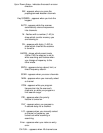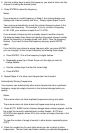For example, if you wanted to search for transmissions between pilots
and the control tower at an air show, you could search only the search
bands where you are most likely to hear the transmissions (4 and 7).
Notes:
The scanner can search for transmissions on frequencies that are not
stored in any of the search bands. For more information, see
"Operation," Faxback Doc. # 38254.
The frequencies in the scanner's search bands are preset.
You cannot change them.
See "Guide to Action Bands," Faxback Doc. # 38257, for lists of other
frequency ranges and the broadcasters you are likely to hear on those
frequencies.
Channel-Storage Banks
To make it easier to identify and select the channels you want to
listen to, channels are divided into 10 channel-storage banks (1-10) of
40 channels each. You can use each channel-storage bank to group
frequencies, such as those used by the police department, fire department,
ambulance services, and aircraft.
For example, there might be three or four police departments in your area,
each using several different frequencies. Additionally, there might be
other law enforcement agencies such as state police, county sheriffs, or
SWAT teams that use their own frequencies. You could program all law
enforcement frequencies starting with Channel 1 (the first channel in
Bank 1), then program the fire department, paramedic, and other public
safety frequencies starting with Channel 41 (the first channel Bank 2).
Monitor Memories
The scanner also has 40 monitor memories that you can use to temporarily
store frequencies while you decide whether to save them into channels.
This is handy for quickly storing an active frequency when you are
searching through an entire band.
You can only store a frequency into a monitor memory during a band, limit,
or direct search.
You can select monitor memories manually, but you cannot scan them.
See "Operation," Faxback Doc. # 38254.
(br/km-03/06/1997)
Handheld Scanner
(200-0564) Operation Faxback Doc. # 38254
TURNING ON THE SCANNER/SETTING VOLUME AND SQUELCH
Note:


















